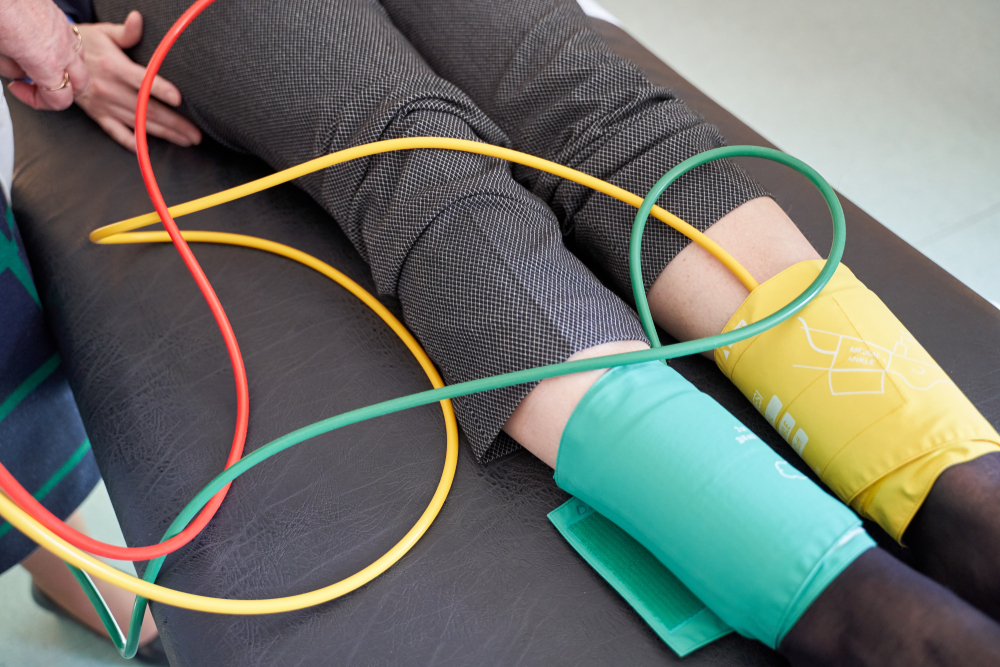Peripheral Arterial Disease (PAD)
Peripheral artery disease, also known as PAD, is a condition where there is a narrowing or blockage in the arteries that supply blood to the limbs, usually the legs. This can cause pain, numbness, and difficulty walking.
At Coastal Vein and Vascular, we specialize in the diagnosis and treatment of PAD and can offer a wide range of treatment options to help improve blood flow and alleviate your symptoms.
What is Peripheral Artery Disease?
Peripheral artery disease is a common circulatory disorder that affects the blood vessels outside of the heart and brain. PAD occurs when plaque, which is a buildup of cholesterol, fat, and other substances, accumulates in the walls of the arteries.
This causes your arteries to narrow and harden. The narrowing reduces blood flow to the limbs, especially the legs.
PAD is also a significant risk factor for heart attack and stroke, as it indicates that plaque may be building up in other parts of the body as well. PAD is common, particularly among older adults and people with a history of smoking, high blood pressure, high cholesterol, or diabetes.
While PAD primarily affects the legs, it can also occur in the arms, stomach, and other parts of the body. With proper diagnosis and treatment, the symptoms of PAD can often be managed, and the risk of complications may reduce.
What are the Symptoms of Peripheral Artery Disease?
If you have PAD, you may feel pain or cramping in your legs when you walk or exercise. This pain can also occur in your thighs or hips and is often described as a dull, achy, or cramping sensation.
Other symptoms of PAD can include numbness or weakness in your legs, coldness in your feet or lower legs, and changes in the color or texture of your skin. Not everyone with PAD experiences symptoms.
In fact, many people with PAD have no symptoms at all. This is why it’s important to talk to your doctor at Coastal Vein and Vascular in New Bern, North Carolina, if you have any concerns about your circulation or if you have any risk factors for PAD.
How is Peripheral Artery Disease Diagnosed?

To diagnose PAD, your doctor will typically start with a physical exam and review of your medical history, including any risk factors for the condition. Your doctor may also order imaging tests to get a closer look at your blood vessels.
At Coastal Vein and Vascular, PAD is diagnosed using Duplex ultrasonography, a non-invasive imaging technique that uses sound waves to create images of the blood vessels. This test is performed in our non-invasive vascular lab and is painless and safe.
If a diagnosis of PAD is confirmed, your doctor may recommend an arteriogram, which involves placing a catheter in an artery and injecting a contrast dye to create detailed images of the blood vessels. This test is performed in our state-of-the-art fluoroscopy suite.
How is Peripheral Artery Disease Treated?
Treatment for PAD depends on the severity of the condition and may involve lifestyle changes, medications, or procedures to improve blood flow to the affected area. Treatment may involve minimally invasive procedures such as balloon angioplasty, atherectomy, or stent placement.
These procedures are done under intravenous conscious sedation provided by a registered nurse to ensure your comfort and safety. In some cases, open surgical treatment, such as arterial bypass, may be necessary.
If this is the case, the experienced surgeons at Coastal Vein and Vascular can perform the procedure at CarolinaEast Medical Center, conveniently located across the street from our practice. It’s important to work closely with your doctor to determine the best treatment plan for you and to take steps to manage your condition to avoid complications.
Do you have symptoms of peripheral artery disease? Request an appointment at Coastal Vein and Vascular in New Bern, NC, today!


